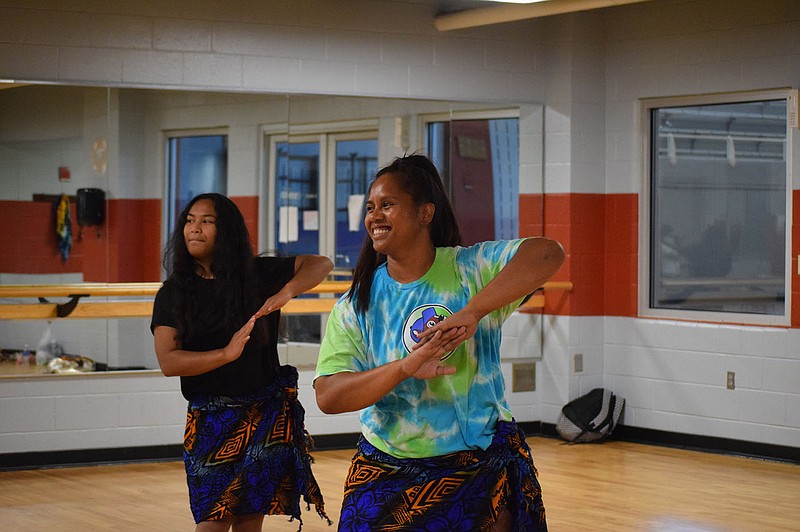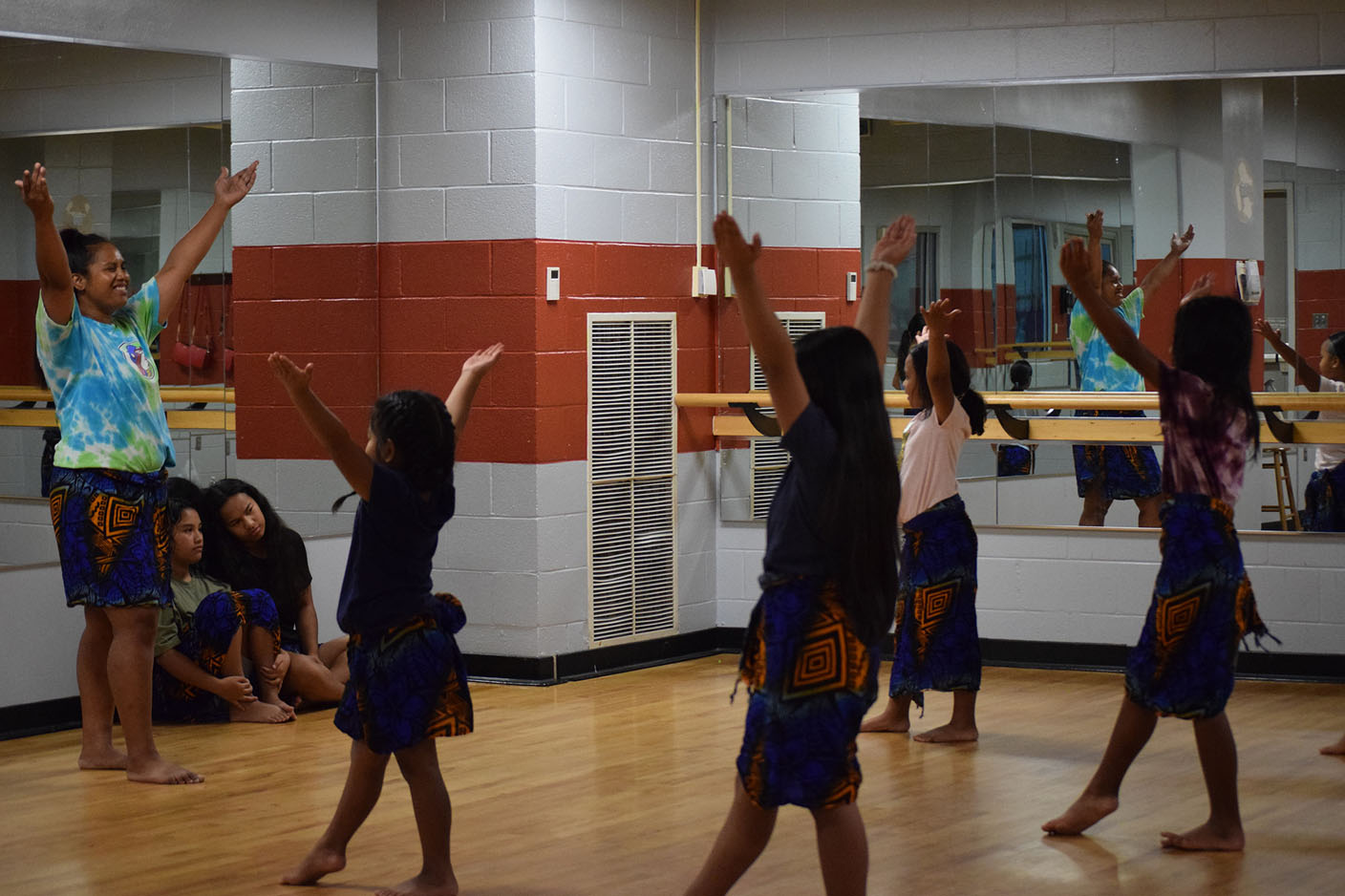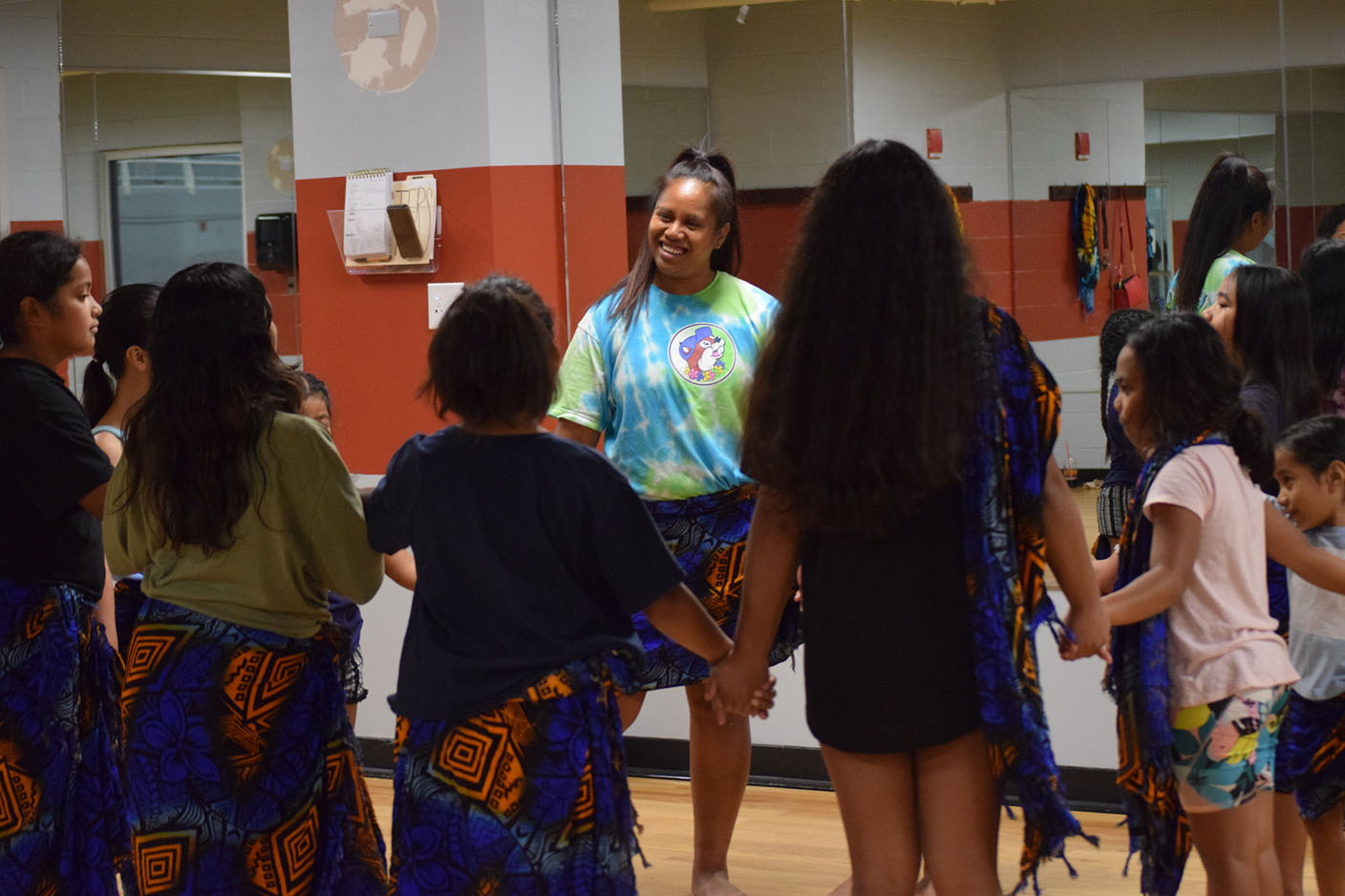Arlynda Jonas radiates positivity. A native of the Marshall Islands, the 28-year-old dancer can often be found with a huge smile on her face, both on and off the stage. She has a joyful, infectious laugh, and a big source of that happiness is dance.
"Dancing I guess saved my life as a kid," she says. "It's helped me with having to be more bold, having to strengthen my weaknesses, strengthen myself as who I am and how I put myself out there."
Growing up, Jonas struggled with her self-esteem and recalls moments of feeling like she wasn't good enough. Dance helped her develop confidence, and now she works to empower other young dancers as the founder and lead instructor of Ocean Wave, a group that performs Pacific Island dances like hula.
"I want these little girls to understand that it's OK that we're not perfect and we're still learning to find ourselves, but just don't lose that confidence and continue building that," she says. "And continue to do what you love to do, which is dancing."
Tryouts are not required to join Ocean Wave because Jonas says the mission of the group is to "educate participants and audiences on Pacific Island cultural traditions and to empower youth to build confidence through this art-specific approach."
Nearly 20 young dancers will demonstrate their skills and share their culture with the broader Northwest Arkansas community during the annual Stroll the Atolls event July 30 in downtown Springdale. Created in 2019 by Arkansas Coalition of Marshallese, the annual festival "strives to create awareness of the Pacific Islanders and display the Marshallese culture in the most interactive way possible," according to organizers.
Arkansas is home to one of the largest populations of Marshallese outside of the Marshall Islands. About 8% of Springdale's population identify as Native Hawaiian or Pacific Islander, according to the U.S. Census Bureau.
This year's celebration will also include an expo July 27 at Crystal Bridges Museum of American Art in Bentonville. The growth of the event as well as support from out-of-state Pacific Island organizations is exciting for Jonas, who views Stroll the Atolls as an educational opportunity.
"It's a way to teach the younger generation and other folks who don't know about our culture and about the Marshall Islands more about who we are, more about what our culture is like and our traditions, and to understand us," she says. "We come from a small island, but we have such a big picture to show other people."
DISCOVERING DANCE
Dressed in a tank top and shorts, a 5-year-old Jonas was surprised by the cold weather that greeted her upon arriving in the United States. It was a drastic change from the tropical climate of the Marshall Islands. It wasn't long before she saw snow for the first time, a frightening sight in their new home in Springfield, Mo.
"Little did we know what we were getting ourselves into," she says.
The young migrant crossed the ocean to reunite with her father, who worked in the U.S. for a few years so he could save enough money to bring his wife and three children to the states. Jonas eventually learned to speak English at school, but she remained connected to her cultural heritage through her family who lived in the area. Two older cousins introduced her to what would become a lifelong passion.
A first birthday celebration -- a kemem -- is a huge tradition in the Marshallese culture, and at 6 years old, Jonas was asked to perform along with other young girls at a kemem. Jonas describes herself as an adventurous, curious tomboy when she was younger, but when it came to learning a dance, she was timid and nervous.
"I was really shy, I didn't even want to expand my arms or smile," she says. "I was very insecure ... everything was just so new to me."
One of those new experiences included wearing a sarong while dancing. Initially the new piece of apparel felt weird, and Jonas didn't like wearing it. However, she decided to give it a try anyway and once they performed, everything changed. That day Jonas realized she loved dancing and wanted to continue practicing the art form.
"I never knew that that was going to take me to a whole new journey of finding out more of who I am and the talents that I have," she says.
Performing and smiling for an audience was new to Jonas, but after that first birthday party, she went home and immediately began observing and critiquing her choreography in the mirror. She also practiced smiling.
"I'd just look at myself and smile," she says, laughing. "It was like the most embarrassing thing ever ... but it was just something that I felt like I needed to master. Every little thing that I learned from my older cousins, it really helped me to be a better dancer."
Throughout elementary school, Jonas taught herself more dances by watching videos her parents helped her find on YouTube. In middle school, her family attended a Polynesian church whose youth group leader was a former dancer from Hawaii who taught hula. When she needed dancers for a family member's graduation, she recruited Jonas and her fellow youth group members.
In addition to hula, Jonas learned Samoan and Tahitian dances, as well as how to make her own costumes. While instructing students on different styles of dance, Jonas' teacher discussed the importance of representing those cultures well when performing their choreography.
"I learned to switch hats and to be able to understand the culture also behind these Pacific Island dances ... so I felt like I was very educated with her," she says.
The dance group practiced regularly in an empty downstairs room at their church. Their numbers grew, and they began performing across the country in places like California, Colorado, Ohio and West Virginia. While Jonas' teacher was stricter than her cousins, Jonas appreciated the opportunity to learn in a different environment.
"She helped us to be fast learners as well, to pick up the pace," she says. "That was one thing that I learned from her and also to be able to feel free when you're dancing and to just be you."
FINDING PURPOSE
There was a time in Jonas' life where she didn't speak up for herself or feel proud of her accomplishments. During this phase, she struggled with depression and questioned what she was meant to do in life.
"What exactly is my purpose? I asked myself that all the time because I would think to myself what is it that I can give, what is it that I can put on the table, what is it that I can do to help out my community and who do I help?" she says.
Sometimes finding your way takes a little bit of patience and faith. For Jonas, faith and dance have often intertwined. After high school, she studied dance for about a year in Kansas City where she participated in a dance program offered by Youth With a Mission, a Christian nonprofit organization.
In late 2013, she moved with her family to Northwest Arkansas, where they began attending church at King's Chapel in Springdale. Jonas helped her parents with the church's youth ministry by teaching dances to young girls. When her parents -- who were pastors -- were recruited back to Springfield, Jonas was asked to lead the church's hula ministry.
Providing instruction to 20 girls -- the majority of whom were 6 to 8 years old -- was overwhelming at times, but Jonas used the skills she learned as a teacher at a local Head Start to assist her with this new challenge.
"It helped me as I was leading the hula ministry because at that Head Start, a lot of kids come from abuse and neglected homes," she says. "I was being told a lot of things from these kids, and I had to learn to faze through that and be able to be more positive with my words towards them. So I learned that, and I think I built a lot more of my patience during that time."
Jonas led the hula ministry for about a year before stepping down because life got busy. In addition to work, she was taking online classes to earn an associate's degree in child development, and she got married.
When she was ready to get back into community work, Jonas connected with local Marshallese organizations and offered to help with events. She also started a hula fitness class as a way to promote a healthy lifestyle among the Marshallese population, which has a high rate of Type 2 diabetes. Besides the health benefits, Jonas' class provided a space for participants to feel free and have fun.
"[For] Marshallese women, hula dancing isn't a thing and shaking your booty isn't a thing, but it was having to get them out of their comfort zone and being able to feel free in that room and trying to be healthy in different ways," she says.
Marshallese dance is more focused on foot and hand movement, and there's not a lot of hip movement, Jonas says. The hand movements can be performed while standing or sitting.
Jonas later switched her focus back to younger students, hosting private lessons in her home. In 2019, Arkansas Coalition of Marshallese's executive director asked if Jonas could choreograph a dance for 20 girls to perform at the inaugural Stroll the Atolls.
The event went so well that parents asked if their kids could stay in the group, so Jonas created Ocean Wave. Today the group consists of more than a dozen girls 6 to 14 years old like Miriam Pedro. She found out about the group through her mom and started taking classes along with her cousin last summer.
Much like Jonas at this age, Pedro watched online videos to learn dances. Sitting still is difficult, so Pedro dances for fun and often does "victory dances out of nowhere."
"It makes me feel happy; I love dancing," she says.
At 14, Pedro is the oldest member of Ocean Wave and says she has enjoyed learning from Jonas, who is "very supportive" and encouraging with students when they make a mistake. Jonas has created an environment where Pedro feels more confident to be herself.
"She's very nice, she's helpful, and she's confident," Pedro says.
On a personal level, the young dancer feels comfortable opening up to her teacher about her emotions. Typically, Pedro says she would simply hide away when she's sad, but Jonas has taught her how to discuss her feelings.
"She's a positive person, a very positive person. She's always happy, and whenever I'm down, she would talk to me," Pedro says. "She actually got me to talk to her and that was very comforting. I feel comfortable around her."
Jonas is impressed by the deep talks she has with her students. Because of their similar backgrounds, she's able to understand where her young dancers are coming from and connect with them. Jonas loves working with this age group and enjoys watching her students grow as dancers and people.
"I love that because I get to witness that and I get to see the works of what I've been doing to be able to help these little girls improve themselves internally and externally," she says.
Looking back on her dancing career, Jonas becomes emotional discussing the impact dance has had on her life.
"When you find something that you really, truly love and that you really want to do in life, you keep a hold of that because that thing that you love the most, it's what's going to help you throughout the way in your life," she says.



